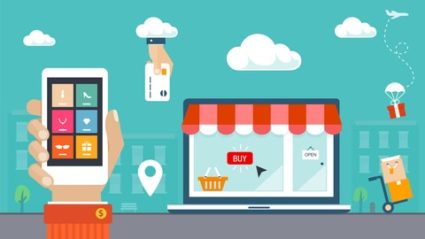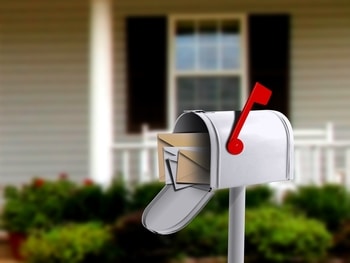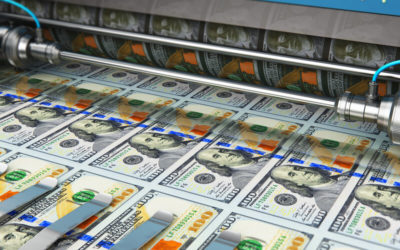Digital marketing has become a critical component of any modern-day marketing plan—especially with the capabilities of websites, social media, and email. These are all familiar digital channels to the smart marketer, and you should use them along with your more “traditional” marketing methods, like your retail location and print marketing campaigns.
Your brick-and-mortar location, and your print and digital marketing channels are all strategic partners. There’s no need to separate them. To get the most out of your marketing efforts, you need an integrated approach that combines all three. It’s called multichannel marketing.
Here’s how to create the perfect multichannel marketing campaign.
Multichannel Marketing Statistics

- Businesses that use multichannel marketing experience a 3x higher effectiveness rate than those that don’t.
- Half of the multichannel marketers say they usually or always hit their financial targets.
- Digital transactions influence 56% of every $1 spent in stores.
- 72% of consumers say they’d prefer to connect with businesses via multichannel marketing.
- More than half of companies today use at least eight marketing channels to interact with their customers.
Multichannel vs. Omnichannel Marketing
Multichannel and omnichannel are two marketing concepts that are compared (and confused) a lot. While it’s true they offer similar methods of marketing your products or services, there’s a distinct difference. Here’s the breakdown.
Multichannel Marketing
Multichannel marketing gives the customer a variety of options in which to make a purchase. You could have a physical store, website, social media accounts, a print catalog, etc. Essentially, you want to maximize your opportunities to connect with consumers. On average, when you add a second channel, you’re increasing your revenue by 38%. If you add a third channel, that revenue jumps to 120%. A fourth channel moves that number to an impressive 190%. You see where these multiple channels are going.
Each of these channels gives your customer another way of doing business with you. Each is a channel with its own goals and strategies. They compliment one another, but they don’t necessarily work hand-in-hand. That’s where omnichannel marketing enters the picture.
Omnichannel Marketing
Omnichannel marketing takes multichannel marketing to another level with the understanding that a customer may want to jump from one channel to another—and they’ll need to do so seamlessly. There needs to be a “hand-off” from one channel to the next without disrupting the buying process. To use a few buzzwords, you’re harmonizing cross-platform touchpoints.
Let’s look at Crate & Barrel as an example. The chain of retail home furnishings stores gives you a tablet computer known as a Mobile Tote to help you shop when you’re in one of their brick and mortar locations. At its core, the tablet will help you search for products and see what’s in stock. If you see something you like, you can scan the item’s barcode for specs and reviews. When you’re finished shopping, just hit the Mobile Tote checkout line and someone will gather your items for you. If you decide not to make a purchase, you can provide your email address, and C&B will save and email your wish list to you. This is one of many possible examples.
Do you want to keep your customers? Give them an omnichannel marketing experience. They’ll give you a 30% higher lifetime value.
Learn more: What is Omnichannel Marketing? | 3 Principles You Need to Follow for Successful Omnichannel Marketing
1. Brick and Mortar Locations
If you have a physical location—or locations—this is where your multichannel marketing mix begins.
As a retailer, you can’t concentrate solely on offline or online sales. They’re both necessary. Merchants who don’t follow suit are likely missing out on valuable sales opportunities. Consider these supporting statistics.
Only 7% of consumers are shopping exclusively online. Compare that to the 73% who use multiple channels throughout their shopping experience. The trend goes in a multichannel direction, especially during the holidays when 25% more consumers plan to make a purchase online, then head to a retail store to retrieve their treasures.
Event Marketing
Whether it’s a trade show or industry event, your brand’s presence is an important part of your overall marketing efforts. Almost 85% of company leaders cite in-person events as vital to their success. Smart marketers agree. In fact, more than 40% believe events are their most effective marketing channel. Here’s an example of how it could work for you.
Let’s say you’re attending a trade show. Assuming you don’t already have an email list for this forthcoming event, you could use direct mail marketing to reach out to registered attendees. Invite them to your booth or speaking engagement with some sort of incentive. For those who accept the invite, you can ask for their email addresses and follow up with them afterward.
If you’re hosting your own event, use it as an opportunity to connect with and learn more about what your customers want. By meeting people face-to-face, you can create a positive experience for them. (By all means, collect email and mailing addresses so you can stay in touch after the event.) Once you convert them into customers, they’ll be more likely to recommend your brand to others.
2. Digital Marketing Channels
A number of channels fall into the digital category of multichannel marketing. From your brand’s website content (desktop and mobile) to your social channels and email campaigns, there are a wide variety of ways to boost your business. Here are a few to focus on.
Website Blog/Landing Page Channels
The content on your website is vital to your brand’s success. As you communicate with and sell to prospects and customers, you’ll need to answer their questions and solve their problems. A branded blog provides the perfect avenue to accomplish this while at the same time boosting SEO and allowing you to measure and track performance.
Your website’s landing pages are built for conversions. They’re an ideal place for consumers to discover what products and/or services you have to offer. Let’s say someone signs up for your e-newsletter. One of your email updates may include a link that takes them to a landing page. The purpose of that landing page is to get them to convert on that particular offer. Another option is to run a paid search campaign where the link directs the prospect to a landing page with the same intention: conversion.
Multichannel Marketing Campaign Examples: Mobile Optimization
The primary way to complement a retail strategy is with an e-commerce website. After all, more than 20% of the world’s population is buying online. By 2021, there will be more than two billion people making online purchases. That’s a market you can’t ignore.
As you’re assembling your multichannel marketing strategy, here’s one important factor to consider. If you’re going to have a successful e-commerce website, you must also cater to mobile visitors/shoppers. More than half of all website visitors are now coming from mobile devices. Thus, one of the keys to success is mobile SEO—and optimizing your website for the discovery and viewing on smartphones and tablets. About 58% of Google searches are from a mobile device, and that percentage is growing rapidly. In fact, Google will penalize you if your site is not optimized for mobile.
Multichannel Marketing Campaign Examples: Social Media Channels

Rather than treating all your incoming social visitors the same, start building a strategy around the traffic source. If someone clicks on a link from Twitter, give them customized content that matches it. That way, their first impression aligns with where they came from. For example, if someone got to your site via Twitter, create a message that thanks them for visiting from Twitter. You could also provide a special Twitter discount code. This creates a nice personal touch that builds upon the micro-conversion they’ve already taken: clicking on your Twitter link. It also moves them one step closer to becoming a customer.
Also, use buy buttons on social wherever possible. Instagram now allows for “shoppable” posts. When someone clicks on a Shop Now button, it takes them to the brand’s website where they can make a purchase.
Multichannel Marketing Campaign Examples: Email Marketing Channels
Email marketing works because it’s inexpensive and it produces results. According to a study, for every $1 spent on email marketing, the return is $44. Plus, almost 75% of consumers say email is their favorite way to communicate with brands.
When it comes to email, however, you can’t rely on one version for each recipient. Success depends on a number of customization factors. You need to tailor the email to individual preferences and where that person is in the buyer’s journey. The more specific you can get to each recipient’s needs, the more success you’ll have. Demographics, past behavior, and variable data personalization all come into play.
Multichannel Marketing Campaign Examples: Pay-Per-Click Ads
The effort you put into getting organic traffic to your valuable content is hard work. Your SEO efforts pay off, however, when you find your blog posts or landing pages on Google’s first page of results for a targeted keyword. But what about those times when it doesn’t work and you don’t make the top 10 results? Is all hope lost? The good news is there are other ways to get your content in front of desired eyes. One of those is pay-per-click ads—the most popular being Google ads.
Organic searches still get more total clicks, but when you’re dealing with keywords that have high commercial intent, paid search ads easily win the battle. Almost 65% of all clicks go to these “sponsored” ads, so consider adding a PPC campaign to your multichannel marketing campaign.
3. Direct Mail Marketing
If you thought email marketing’s statistics were impressive, wait until you hear about direct mail. People of all ages generally love receiving mail on a regular basis. Almost 90% of it is opened. The response rate is 37% higher than email. Plus it requires 21% less cognitive effort to process. Thus, it’s typically easier to understand and remember. When you combine the two on a marketing campaign you get the ultimate return on your investment.
Research shows that consumers spend (on average) 25% more when direct mail is used in combination with email. By strategically combining your direct mail and digital channels (like with QR code marketing), you can maximize your marketing and create the perfect multichannel marketing campaign. Here are a few examples featuring automation.
Automation Strategy Examples
If someone doesn’t respond to your email message, send them a direct mail piece. It’s easy to arrange this as part of an automation strategy. That way you don’t need to manually send a message to everyone that doesn’t respond.
You can try the same thing in reverse. Begin by sending a direct mail campaign and give recipients a pURL to their own landing page. When they visit the page, it triggers an email to follow up with the prospect.
You can also combine direct mail with an email drip campaign. These automated campaigns are successful enough on their own. Opens and click-through rates for drip campaigns are up to 80% higher than a single email send. Smart marketers are adding direct mail to the mix, though. It separates their campaigns from the many other automated campaigns that only feature email.
4. More Multichannel Marketing Methods
To create the perfect multichannel marketing campaign, you’ll also need to consider a few additional (and traditional) channels. While not as popular as digital and direct mail, these channels are still worth a look, depending upon your target market.
- Television. TV and mobile work well together. How many times have you seen a hashtag overlay during a TV show or event? Nielsen says at least one-third of active Twitter users tweet about what they’re watching on TV. Only desktop/mobile is a better combo.
- Radio. In multichannel marketing campaigns, radio is still considered one of the most effective forms of advertising. Most radio stations have controlled demographics and it’s generally not as expensive as TV. Plus, 93% of adults listen to the radio on a weekly basis. That’s more reach than TV and smartphones.
- Media coverage. There’s an old saying: “All publicity is good publicity.” Well, it might be better to say: “Free publicity is good publicity.” A more commonly used term in the marketing world is “earned placements.” Create press releases and distribute them to local newspapers, influential bloggers, etc. Make your strategy proactive instead of reactive, though. Then measure your results to make sure the coverage you receive outweighs the effort you put into it.
Discover Multichannel Marketing
When you want to create the perfect marketing strategy, the best route features a modern-day mix of both digital and traditional methods. By combining your physical location with digital and print marketing channels, you’re putting yourself in the best position to be successful.
MSP can help you create a marketing strategy that incorporates your brick-and-mortar, web-to-print marketing materials with print and digital solutions. Contact MSP for a free consultation today.
How Effective is Direct Mail Marketing?
As a smart marketing professional, you know that direct mail is a wise choice to include in your multichannel arsenal. But exactly how effective is direct mail marketing? We're here to answer that question for you. Direct Mail Marketing Continues to Grow ...
How to Optimize Your Direct Mail Postcards
Marketers from every industry love direct mail postcards because they're affordable and effective ways to advertise their products and services. So we applied our 65+ years of knowledge and came up with a few tricks you can use to boost your results. Here's how to...
Direct Mail Advertising Costs: Here’s What to Look For
Marketers want to know how to get the best return for their advertising dollars. So we assembled the typical direct mail costs to show you what's involved and what options you'll have when it's time to plan your next direct mail campaign. Direct Mail...








